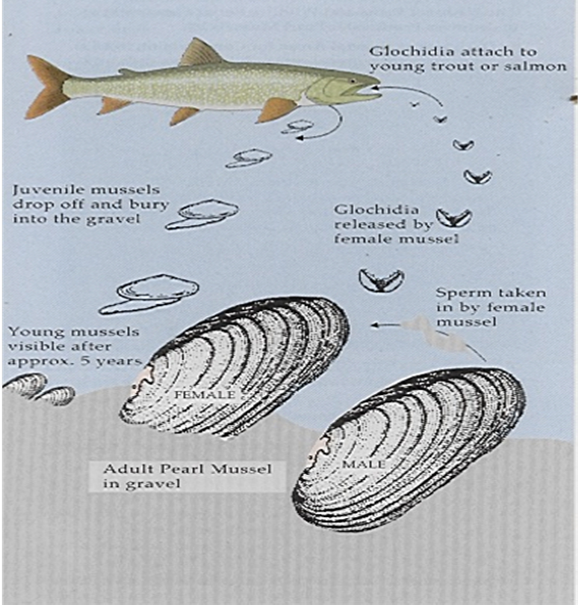
The decline of the freshwater pearl mussel has resulted from failure to recruit young mussels to populations. The cause of these recruitment failures is damage to the species’ habitat, specifically through hydrological, sedimentation, other morphological and enrichment impacts.
The species is extremely sensitive to environmental perturbations, owing to its complex life-cycle and vulnerable habitat. It is very long-lived, surviving for between 35 and 200 years across its natural range (c. 100-years, on average, in Ireland). Juvenile and young freshwater pearl mussels are even more sensitive than adult mussels, as they live buried in the substratum for five or more years. This habit prevents the very small mussels from being washed away by fast-flowing water, but leaves them particularly vulnerable to habitat degradation. Subtle changes in hydrology can lead to erosion and permanent loss of juvenile substratum, as well as damage through habitat exposure during low-flow. Hydrological changes can also exacerbate sedimentation and enrichment impacts. Sediment settling on and in the river bed creates a physical barrier to water circulation, depriving buried mussels of an oxygen supply. By clogging interstitial spaces, fine sediment may also prevent new juveniles from moving into the substratum. Increased nutrient loads promote growth of filamentous algae, diatoms and other algae that also act as physical barriers between the open water and the river bed. Where mussel habitat is impacted by increases in both fine sediment and nutrients, rooted plants expand and tend to further exacerbate the problem. Respiration of rooted plants and algae causes night-time drops in oxygen in mussel habitats.
Organic matter contributes significantly to the degradation of freshwater pearl mussel habitat, because decomposers have high oxygen demands and can cause severe deoxygenation of the river bed, as well as creating the physical barrier of fungal and bacterial biomass. Organic matter may be particulate (of various sizes) or dissolved and can originate from within the river itself (e.g. dying algae or rooted plants) or be lost to water from land. Land-based losses can come from human waste, animal waste (e.g. slurry or farmyard manure), industrial effluents, decomposition of organic matter in soils (e.g. where peat or peaty soils are drained or otherwise damaged), decaying vegetation (e.g. needles and woody debris left behind after clear-fell harvesting of plantation forestry), and other sources.
The freshwater pearl mussel ensures its survival by existing in large populations and producing large numbers of offspring every year. The resilience of a population is increased through its distribution and density, as well as its absolute size. Viable populations have a widespread distribution, occupying all available habitat in high densities. As the juvenile mussels remain buried in the river substratum for a period of five or more years, the habitat must be constantly maintained in good condition over the long-term. Even temporary declines in condition can lead to the loss of all juveniles produced in the previous five years.
